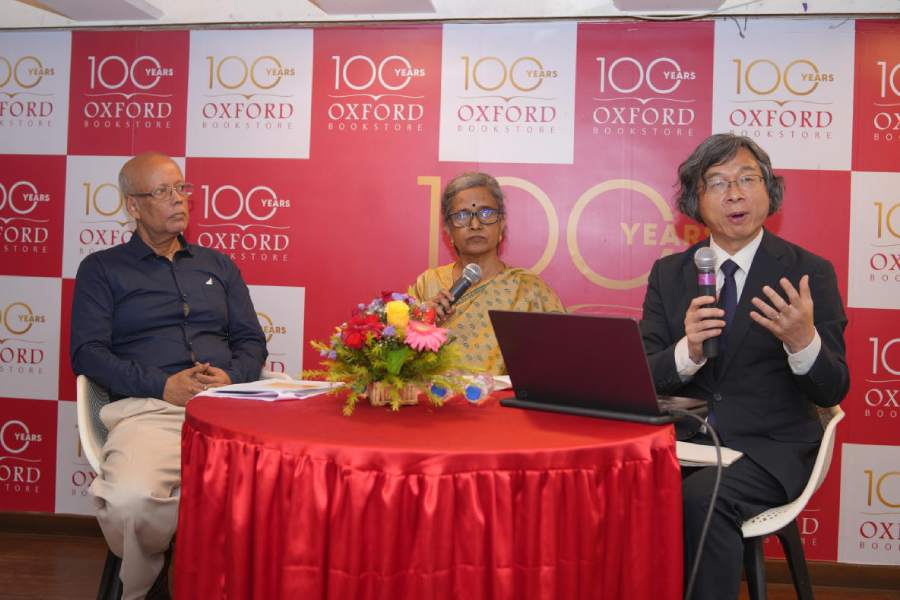Love for Japanese literature brought the literati together at an event organised by the Consulate General of Japan in collaboration with Oxford Bookstore recently. Purabi Gangopadhyay moderated the conversation. The discourse delved into life and cultural relations through literary works and ingrained philosophies. The relevance of the works of Rabindranath Tagore enhanced the course of conversation wherein parts of Japanese literature were cited and related to his songs and poems.
Maeda Akira, vice consul, Consulate General of Japan in Calcutta, provided a precise overview of Man’yoshu, a famous ancient work of Japanese literature. Man’yoshu, the oldest anthology of Waka poems, is the only written record that provides a glimpse into the works of Kakinomoto no Hitomaro, one of the most famous poets of Japan. Life and water can be effortlessly interwoven together and works of both Tagore and Hitomaro are reflective of the same. Professor Komatsu Yasuhiko of the Department of Japanese Language and Literature and director of International Center, Aoyama Gakuin University, enlightened the audience by elucidating the Waka poems by Hitomaro contained in Man’yoshu. The main theme of Hitomaro’s works is “separation and love” and the threads of this concept seem to be strongly woven into several works of Tagore, be it Strir Potro or his love songs from Volume 2 of Geetobitan under the title Prem.
Nature and its elements found profound creativity in the way Tagore and Hitomaro expressed themselves. “The familiarity and profound respect for water shown by two poets from different time and region will absolutely enrich human life even further, moreover foster the intricate bond between nature and human beings,” said Prof Komatsu.
Water as imagery has been extensively used as a significant poetic device in many of Hitomaro’s works. Be it swinging water plants as sensual love or the death of a young lady, the image of water has been implied in both life and death. According to Hitomaro’s philosophy, water has the sacred
power which gives delight and console to lovers, while being closely associated with death and loss at the same time. Professor Komatsu drew parallels to the sea of Tagore’s poetry. He mentioned Iwami Somonka, (love poems in Iwami) a masterpiece by Hitomaro is reminiscent of
Gitanjali (in English) No. 87, an elegy for Tagore’s lost beloved wife, Mrinalini Devi.
Abhijit Mukherjee, a Bengali translator of Japanese novels and Japanese language teacher, elaborated on the aspects of continuity in Japanese novels since its inception to the present day’s worldwide popularity and the remarkable relevance of Tagore to the philosophical premises.
Mukherjee cited an example to explain the same. The Booker Prize Foundation conducted a survey in the UK, in which 14 of the top 30 translated fiction books were from Japanese literature. This is reflective of the fact that Japanese literature is dominating the international market with the narrative style having a more cosmopolitan appeal.
Mukherjee also spoke about the significance of reading and relating to Japanese literature as he stated, “We Bengalis are very privileged readers of Japanese fiction. What constitutes the canon of Japanese fiction is that for each novel you can find a Tagore song at the core or at important junctures.”
If one goes through the lyrics of Tagore’s song Tomaro ashimey, prano, mono loye, one can realise how intricately it embraces heart, mind, life and longing. It is quite noteworthy how Tagore’s works strikingly enable an individual to capture the very spirit, perception and essence of Japanese literature, thus comprehending its appeal to both art and life. “Man’yoshu expresses the Japanese people’s mentality. Everything has a spirit and life, even rivers, rocks and trees. That is related to the spirit that we live in. This session was a witness to an insightful exchange of knowledge sharing and I am extremely grateful to everybody who attended this
evening,” said Maeda.
